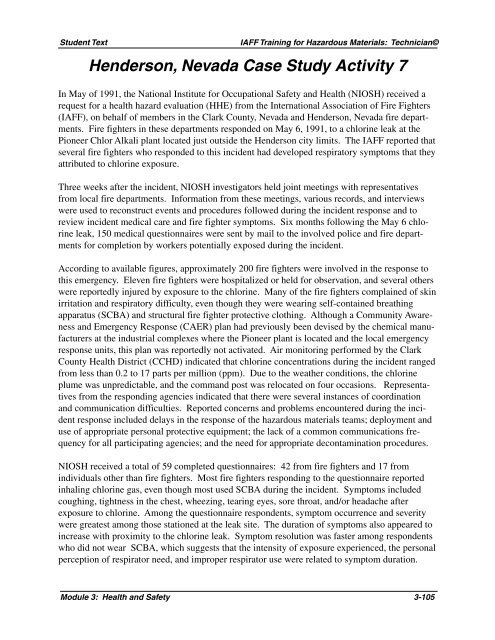Module 3: Health and Safety - IAFF
Module 3: Health and Safety - IAFF
Module 3: Health and Safety - IAFF
You also want an ePaper? Increase the reach of your titles
YUMPU automatically turns print PDFs into web optimized ePapers that Google loves.
Student Text <strong>IAFF</strong> Training for Hazardous Materials: Technician©<br />
Henderson, Nevada Case Study Activity 7<br />
In May of 1991, the National Institute for Occupational <strong>Safety</strong> <strong>and</strong> <strong>Health</strong> (NIOSH) received a<br />
request for a health hazard evaluation (HHE) from the International Association of Fire Fighters<br />
(<strong>IAFF</strong>), on behalf of members in the Clark County, Nevada <strong>and</strong> Henderson, Nevada fire departments.<br />
Fire fighters in these departments responded on May 6, 1991, to a chlorine leak at the<br />
Pioneer Chlor Alkali plant located just outside the Henderson city limits. The <strong>IAFF</strong> reported that<br />
several fire fighters who responded to this incident had developed respiratory symptoms that they<br />
attributed to chlorine exposure.<br />
Three weeks after the incident, NIOSH investigators held joint meetings with representatives<br />
from local fire departments. Information from these meetings, various records, <strong>and</strong> interviews<br />
were used to reconstruct events <strong>and</strong> procedures followed during the incident response <strong>and</strong> to<br />
review incident medical care <strong>and</strong> fire fighter symptoms. Six months following the May 6 chlorine<br />
leak, 150 medical questionnaires were sent by mail to the involved police <strong>and</strong> fire departments<br />
for completion by workers potentially exposed during the incident.<br />
According to available figures, approximately 200 fire fighters were involved in the response to<br />
this emergency. Eleven fire fighters were hospitalized or held for observation, <strong>and</strong> several others<br />
were reportedly injured by exposure to the chlorine. Many of the fire fighters complained of skin<br />
irritation <strong>and</strong> respiratory difficulty, even though they were wearing self-contained breathing<br />
apparatus (SCBA) <strong>and</strong> structural fire fighter protective clothing. Although a Community Awareness<br />
<strong>and</strong> Emergency Response (CAER) plan had previously been devised by the chemical manufacturers<br />
at the industrial complexes where the Pioneer plant is located <strong>and</strong> the local emergency<br />
response units, this plan was reportedly not activated. Air monitoring performed by the Clark<br />
County <strong>Health</strong> District (CCHD) indicated that chlorine concentrations during the incident ranged<br />
from less than 0.2 to 17 parts per million (ppm). Due to the weather conditions, the chlorine<br />
plume was unpredictable, <strong>and</strong> the comm<strong>and</strong> post was relocated on four occasions. Representatives<br />
from the responding agencies indicated that there were several instances of coordination<br />
<strong>and</strong> communication difficulties. Reported concerns <strong>and</strong> problems encountered during the incident<br />
response included delays in the response of the hazardous materials teams; deployment <strong>and</strong><br />
use of appropriate personal protective equipment; the lack of a common communications frequency<br />
for all participating agencies; <strong>and</strong> the need for appropriate decontamination procedures.<br />
NIOSH received a total of 59 completed questionnaires: 42 from fire fighters <strong>and</strong> 17 from<br />
individuals other than fire fighters. Most fire fighters responding to the questionnaire reported<br />
inhaling chlorine gas, even though most used SCBA during the incident. Symptoms included<br />
coughing, tightness in the chest, wheezing, tearing eyes, sore throat, <strong>and</strong>/or headache after<br />
exposure to chlorine. Among the questionnaire respondents, symptom occurrence <strong>and</strong> severity<br />
were greatest among those stationed at the leak site. The duration of symptoms also appeared to<br />
increase with proximity to the chlorine leak. Symptom resolution was faster among respondents<br />
who did not wear SCBA, which suggests that the intensity of exposure experienced, the personal<br />
perception of respirator need, <strong>and</strong> improper respirator use were related to symptom duration.<br />
<strong>Module</strong> 3: <strong>Health</strong> <strong>and</strong> <strong>Safety</strong> 3-105
















